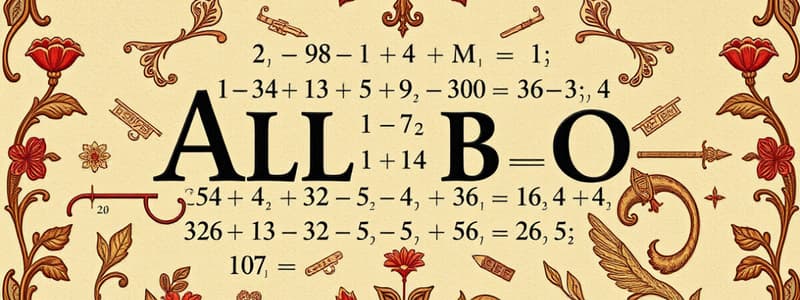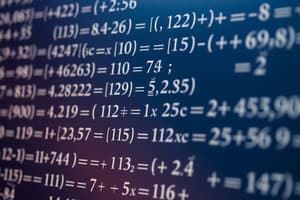Podcast
Questions and Answers
What is the additive inverse to a?
What is the additive inverse to a?
- expression^1/n
- 1/a
- 1/(expression)^n
- -a (correct)
What is the multiplicative inverse to a (when a does not equal 0)?
What is the multiplicative inverse to a (when a does not equal 0)?
1/a
What does raising an expression to a negative exponent equal?
What does raising an expression to a negative exponent equal?
1/b^n
How do you multiply expressions with powers?
How do you multiply expressions with powers?
What is the result of raising expressions to powers?
What is the result of raising expressions to powers?
What is the formula for dividing expressions with powers?
What is the formula for dividing expressions with powers?
What do fractional exponents represent?
What do fractional exponents represent?
What is the result of multiplying radicals?
What is the result of multiplying radicals?
What is the formula for factoring the difference of two squares?
What is the formula for factoring the difference of two squares?
What is the formula for factoring perfect squares?
What is the formula for factoring perfect squares?
How is the slope of a line determined given two points?
How is the slope of a line determined given two points?
What is the equation of a line in slope-intercept form?
What is the equation of a line in slope-intercept form?
What is the point-slope form of a line given two points?
What is the point-slope form of a line given two points?
What is the intercept form of a line given x and y intercepts?
What is the intercept form of a line given x and y intercepts?
What is the condition for slopes of perpendicular lines?
What is the condition for slopes of perpendicular lines?
How is the discriminant used to determine the number of real solutions?
How is the discriminant used to determine the number of real solutions?
What does logarithm addition state?
What does logarithm addition state?
What does logarithm subtraction state?
What does logarithm subtraction state?
What is the logarithm power rule?
What is the logarithm power rule?
What is the formula for an arithmetic sequence?
What is the formula for an arithmetic sequence?
What is the sum of arithmetic sequences?
What is the sum of arithmetic sequences?
What is the formula for a geometric sequence?
What is the formula for a geometric sequence?
What is the sum of geometric sequences?
What is the sum of geometric sequences?
What is the sum of infinite geometric sequences?
What is the sum of infinite geometric sequences?
What is the definition of a factorial?
What is the definition of a factorial?
What is the combination formula of n choose r?
What is the combination formula of n choose r?
What is the determinant of a 2x2 matrix represented as?
What is the determinant of a 2x2 matrix represented as?
How do you find the additive inverse of an expression?
How do you find the additive inverse of an expression?
What is the result of raising an expression to a negative number?
What is the result of raising an expression to a negative number?
What does raising to a fractional power signify?
What does raising to a fractional power signify?
How can you determine whether a graph is a function?
How can you determine whether a graph is a function?
How do you verify if a graph matches that of an algebraic function?
How do you verify if a graph matches that of an algebraic function?
How do you find the domain given y=f(x)?
How do you find the domain given y=f(x)?
How do you graph a line given y=mx+b?
How do you graph a line given y=mx+b?
What indicates whether a graph is odd, even, or neither?
What indicates whether a graph is odd, even, or neither?
How do you describe transformations given f(x)?
How do you describe transformations given f(x)?
How do you determine how many roots a given graph has?
How do you determine how many roots a given graph has?
What is the maximum and minimum number of roots for a polynomial of degree n?
What is the maximum and minimum number of roots for a polynomial of degree n?
How do you determine the roots given f(x)?
How do you determine the roots given f(x)?
Flashcards
Additive Inverse
Additive Inverse
The opposite of a number, which when added to the original number, results in zero.
Multiplicative Inverse
Multiplicative Inverse
The reciprocal of a non-zero number, which when multiplied by the original number, equals 1.
Negative Exponent
Negative Exponent
For b⁻ⁿ, it's 1/bⁿ.
Exponent Addition
Exponent Addition
Signup and view all the flashcards
Exponent Raising
Exponent Raising
Signup and view all the flashcards
Exponent Subtraction
Exponent Subtraction
Signup and view all the flashcards
Fractional Exponents
Fractional Exponents
Signup and view all the flashcards
Multiplying Radicals
Multiplying Radicals
Signup and view all the flashcards
Difference of Squares
Difference of Squares
Signup and view all the flashcards
Perfect Squares
Perfect Squares
Signup and view all the flashcards
Cubes Factoring
Cubes Factoring
Signup and view all the flashcards
Slope from Points
Slope from Points
Signup and view all the flashcards
Slope-Intercept Form
Slope-Intercept Form
Signup and view all the flashcards
Point-Slope Form
Point-Slope Form
Signup and view all the flashcards
Intercept Form
Intercept Form
Signup and view all the flashcards
Perpendicular Lines
Perpendicular Lines
Signup and view all the flashcards
Discriminant
Discriminant
Signup and view all the flashcards
Logarithm Addition
Logarithm Addition
Signup and view all the flashcards
Logarithm Subtraction
Logarithm Subtraction
Signup and view all the flashcards
Power Rule (Logs)
Power Rule (Logs)
Signup and view all the flashcards
Arithmetic Sequence
Arithmetic Sequence
Signup and view all the flashcards
Sum of Arithmetic Sequence
Sum of Arithmetic Sequence
Signup and view all the flashcards
Geometric Sequence
Geometric Sequence
Signup and view all the flashcards
Sum of Geometric Sequence
Sum of Geometric Sequence
Signup and view all the flashcards
Infinite Geometric Series
Infinite Geometric Series
Signup and view all the flashcards
Factorial
Factorial
Signup and view all the flashcards
Combination
Combination
Signup and view all the flashcards
Study Notes
Algebraic Concepts
- Additive Inverse: The additive inverse of a number 'a' is -a.
- Multiplicative Inverse: The multiplicative inverse of a non-zero number 'a' is 1/a.
- Negative Exponent Rule: Raising an expression 'b' to a negative exponent 'n' is equivalent to 1/b^n.
- Exponent Addition: When multiplying expressions with the same base, x^n * x^m = x^(m+n).
- Exponent Raising: (x^m)^n simplifies to x^(m*n).
- Exponent Subtraction: For division, x^m / x^n = x^(m-n).
Advanced Exponents and Radicals
- Fractional Exponents: x^(1/2) represents the square root of x, and x^(m/n) denotes the n-th root of x^m.
- Multiplying Radicals: The product of two square roots is √a * √b = √(ab).
Factoring Techniques
- Difference of Squares: x^2 - y^2 factors into (x - y)(x + y).
- Perfect Squares: x^2 + 2xy + y^2 = (x + y)^2 and x^2 - 2xy + y^2 = (x - y)^2.
- Cubes Factoring: x^3 + y^3 = (x + y)(x^2 - xy + y^2) and x^3 - y^3 = (x - y)(x^2 + xy + y^2).
Slope and Line Equations
- Slope from Points: Given two points, the slope (m) is calculated as m = (y2 - y1) / (x2 - x1).
- Slope-Intercept Form: The equation of a line can be expressed as y = mx + b, where m is the slope and b is the y-intercept.
- Point-Slope Form: For a line through point (x1, y1) with slope m: (y - y1) = m(x - x1).
- Intercept Form: Expressed as x/a + y/b = 1, where a and b are x and y intercepts respectively.
Graphing and Properties
- Perpendicular Line Slopes: Slopes of perpendicular lines are negative reciprocals of each other.
- Discriminant: Used to determine the number of real solutions:
- If b^2 - 4ac > 0, there are 2 real solutions.
- If b^2 - 4ac = 0, there is 1 real solution.
- If b^2 - 4ac < 0, there are no real solutions but 2 imaginary solutions.
Logarithmic Operations
- Addition of Logarithms: log a + log b = log(ab).
- Subtraction of Logarithms: log a - log b = log(a/b).
- Power Rule: log a^b = b log a.
Sequences
- Arithmetic Sequence: Defined as an_n = a1 + (n - 1)d, where d is the common difference.
- Sum of Arithmetic Sequences: Calculated using Sn = n/2[2a1 + (n - 1)d] or Sn = n/2(a1 + a2).
- Geometric Sequence: An expression a_n = a1 * r^(n-1), where r is the common ratio.
- Sum of Geometric Sequences: Calculated as Sn = [a1(1 - r^n)] / (1 - r).
- Infinite Geometric Series: Sn = a1 / (1 - r), valid for |r| < 1.
Combinatorics and Linear Algebra
- Factorial: Defined as n! = n(n - 1)(n - 2)...321.
- Combination Formula: nCr = n! / (r!(n - r)!).
- Determinant of a 2x2 Matrix: For a matrix with elements a, b, c, d, the determinant is ad - bc.
Additional Concepts
- Vertical Line Test: Used to determine whether a graph represents a function.
- Domain Determination: Domain exceptions occur when:
- The denominator equals zero.
- An even root yields a negative number.
- The logarithm of zero or a negative number occurs.
- Graph Symmetry: Functions are even if symmetrical about the y-axis and odd if symmetrical about the origin.
- Transformations: Adjustments to functions include vertical shifts, horizontal shifts, and reflections across axes.
Polynomial Roots
- Root Analysis: The number of roots corresponds to how many times the graph touches or crosses the x-axis.
- Max and Min Roots:
- For a polynomial of degree n, the maximum number of real roots is n.
- If n is even, the minimum is 0; if n is odd, the minimum is 1.
Studying That Suits You
Use AI to generate personalized quizzes and flashcards to suit your learning preferences.




